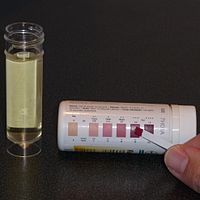
Photo from wikipedia
Objectives: To detect resting-state functional MRI (rsfMRI) changes and their relationships with the clinical curative effect of anti-epileptic drugs (AEDs) for complex partial seizures (CPS) in epilepsy patients using the… Click to show full abstract
Objectives: To detect resting-state functional MRI (rsfMRI) changes and their relationships with the clinical curative effect of anti-epileptic drugs (AEDs) for complex partial seizures (CPS) in epilepsy patients using the fractional amplitude of low frequency fluctuation (fALFF). Methods: rfMRI data from 14 CPS patients enrolled between June 2015 and June 2016 in Department of Neurology, Affiliated Hospital of Inner Mongolia Medical University were retrospectively investigated and compared with findings from 14 healthy age-, gender-, handedness-, and education-matched subjects. The patients were treated with first-line antiepileptic drugs for 12 weeks before undergoing a second rfMRI scan. fALFF data were processed using REST and SPM8 software. Whole-brain data were compared between the 2 groups. Results: The abnormal findings in CPS patients significantly decreased or disappeared after AED treatment. Conclusion: Measuring fALFF is useful for identifying brain functional changes in patients with first-episode epilepsy before and after treatment. Performing rfMRI is useful for evaluating treatment responses and may provide new insight into the pathophysiological mechanisms of epilepsy.
Journal Title: Neurosciences
Year Published: 2017
Link to full text (if available)
Share on Social Media: Sign Up to like & get
recommendations!